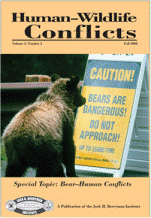Center, Internet, Wildlife Damage Management

Human–Wildlife Interactions
Date of this Version
Spring 2009
Document Type
Article
Abstract
Feral hogs (Sus scrofa) are a widespread exotic species that currently occur in most states within the United States and are common throughout the southeastern United States. We radio-collared and tracked feral hogs from April 2005 to November 2006 in Congaree National Park (CNP), South Carolina, USA. The CNP is one of the largest and most intact tracts of old-growth, bottomland hardwood forest remaining in the United States. We measured home range size and determined habitat use for male and female hogs. The mean (± SE) home range sizes for male hogs (n = 7) and female hogs (n = 9) were 218 ± 43 ha and 191 ± 31 ha, respectively. These home range estimates are relatively small compared to estimates from other studies of feral hogs. Habitat use models indicated that high use areas for hogs included habitat types best characterized as bottomland hardwoods and that hog locations were distributed in a relatively uniform manner throughout the study area within CNP. The small home ranges and habitat use patterns we observed suggest that habitat quality in CNP is good for feral hogs. Radio-collared hogs also moved readily between park and private lands. Thirteen of 23 collared hogs were found on private lands adjacent to CNP at least once. At least eight of the 23 collared hogs were shot and killed by hunters and one of these was taken on CNP land. If control of hogs in CNP were a goal of resource managers, then it would likely succeed or fail based in large part on the incorporation of adjacent private lands into the program.


Comments
Published in Human–Wildlife Conflicts 3(1):49–63, Spring 2009. Published by Jack H. Berryman Institute http://www.berrymaninstitute.org/journal/index.html